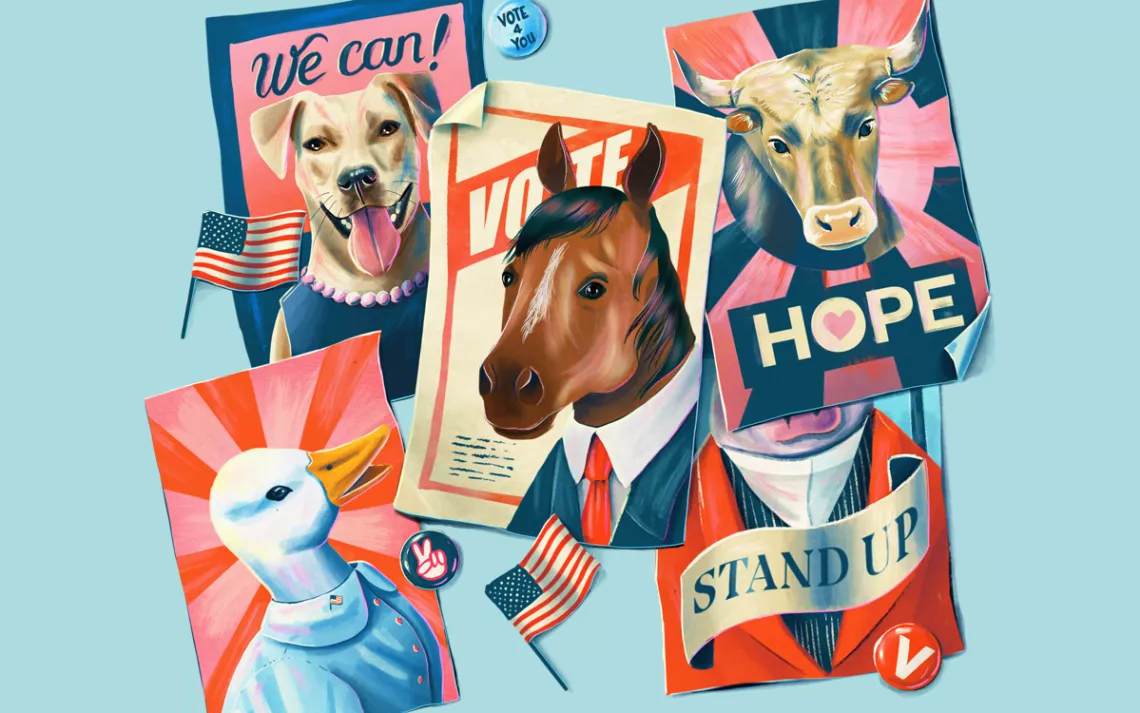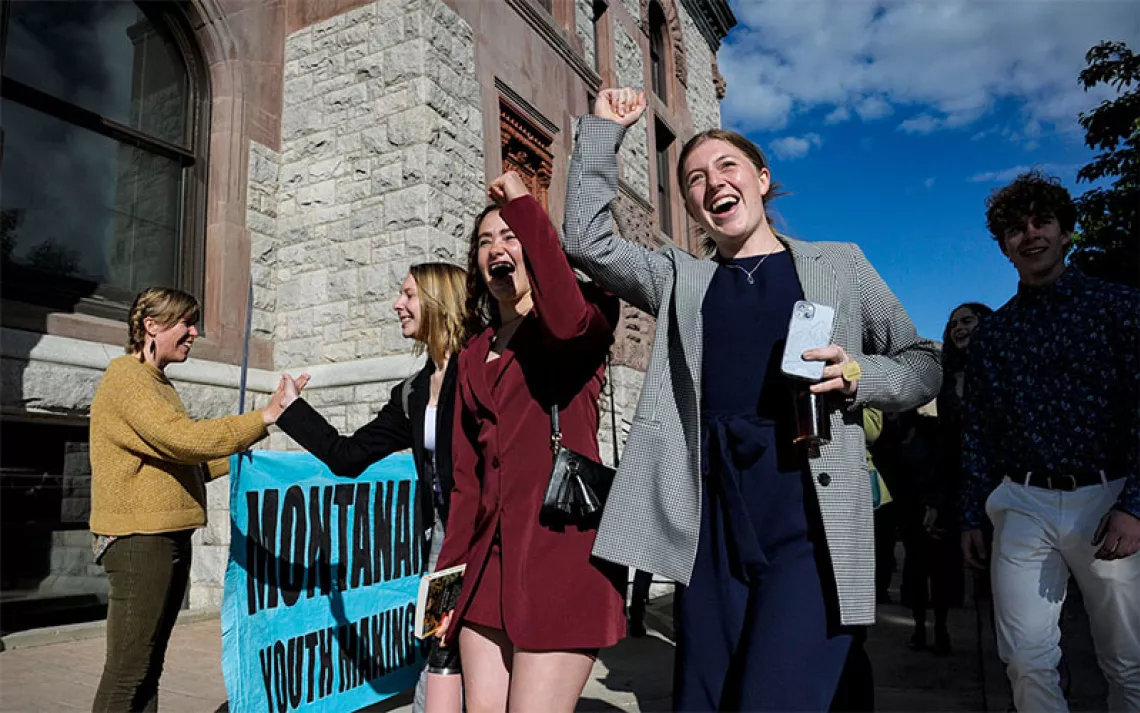Political Animals Like Us
Politics can be a ruthless game for any species

Illustration by Katty Huertas
This fall, as in every political season, the media is full of animal metaphors. Few are flattering, either to the people they describe or the species they invoke: Candidates face off in horse races while term-limited incumbents metamorphose into lame ducks. Presidents take advantage of bully pulpits while politicians who take unconventional positions are mavericks, a frontier-era nickname for unbranded calves. One study of modern Chinese political discourse found similar associations, reporting that political opponents were described as grasshoppers, ants, praying mantises, and "frogs living in the bottom of a well." From Aesop's Fables to George Orwell's Animal Farm to today's cable-news chyrons, politics is imagined as a contest among nonhuman animals—a contest that the strongest and most ruthless are destined to win.
This language reflects a limited view not only of politics but also of the relationships within and among other species. As author Kristin Ohlson writes in her elegant new book Sweet in Tooth and Claw (Patagonia Books, 2022), "Such metaphors of constant struggle and selfishness are like a dark lens slipped over the eye, changing the colors of the world around us to gray."
What might it mean for our language, and politics, if we were to see our fellow animals in full color?
As Ohlson writes, science's long-standing preoccupation with competition has several possible explanations. Competition is, of course, integral to Charles Darwin's theory of evolution by natural selection, but Darwin acknowledged that cooperation was important too, writing in The Descent of Man that "communities which included the greatest number of the most sympathetic members would flourish best and rear the greatest number of offspring." Such caveats were ignored by proponents of "social Darwinism," who in the late 1800s caricatured Darwin's theory as "the survival of the fittest" and used it to justify inequality in human societies. Biologist Douglas Boucher, a student of cooperative relationships in other species, suggests to Ohlson that the political and social upheavals of the 20th century confirmed the assumption that competition is "an overwhelming fact of life." Lynn Margulis, the biologist who proposed in the late 1960s that complex cells evolved via mutually beneficial relationships between simpler cells—a once-radical theory that is now broadly accepted—hazarded during her lifetime that scientists tended to study competition rather than cooperation because science was dominated by men.
One of the few early champions of the study of cooperation was Peter Kropotkin, the Russian scientist and anarchist who wrote the 1902 book Mutual Aid. Kropotkin was an admirer of Darwin's; when he traveled to the Russian steppes and mountains, he observed both competition and "mutual support, mutual aid, and mutual defense" among living things. The ability to cooperate, he concluded, is essential for protection against predators and the elements, making it "as much a law of nature as mutual struggle."
The stories in Sweet in Tooth and Claw make clear that Kropotkin and Darwin were right: Other species do benefit from mutual aid. Researchers have found that when organisms work together—by snuggling for warmth, say—they can "relax" the selective pressures acting upon them, allowing for more variation within populations and, as a result, a greater collective capacity to adapt to changing conditions. Ohlson profiles forest ecologist Suzanne Simard, the author of Finding the Mother Tree, who has found that different species of forest trees share sugars and exchange chemical messages through underground fungal networks.
Ohlson wisely includes humans in her survey, and several of her chapters profile cooperative efforts between humans and other species. She spends time in the high desert of northern Nevada, where in the 1980s heavy cattle grazing reduced once-lush creek sides to bare dirt. Since then, changes in grazing practices have given streamside plants a chance to recover; beavers, drawn by the new greenery, have returned to the area and built dams, slowing down water flow and allowing the young vegetation to expand still farther. The result is more forage for cattle, more wildlife habitat, and more honest and productive relationships among ranchers and land managers—notable in a region where disputes over public-land grazing policies have repeatedly led to violence. "I thought I knew this land," one rancher reflects. "I grew up here, but I didn't know what I didn't know until we started this process."
The regenerative agriculture experiments that Ohlson visits in South Dakota, California, and southern Mexico have yielded similarly promising benefits for humans and other species. Green roofs, once a novelty, are providing habitat to wildlife in cities around the world—while also shielding the building residents from extreme temperatures. While Ohlson readily acknowledges that these and other innovations are not sufficient to ensure our own and other species' survival, she sees great potential in their cooperative spirit. "We humans expect much of our own ingenuity and cleverness," she writes, "but we often fail to consider that many of the answers we seek already exist and are part of the greater creativity—and generosity—of nature."
Like cooperation, competition in the nonhuman world takes many forms. In Power in the Wild (University of Chicago Press, 2022), biologist and science historian Lee Alan Dugatkin shows that strength and ruthlessness are only two of the many possible assets an organism may bring to a contest. Dugatkin—who, as it happens, is also the author of a fine short biography of Peter Kropotkin, called The Prince of Evolution—has studied cooperation and competition within and among other species and observes that both involve "subtle, nuanced assessments and decisions."
In studies of nonhuman communities, Dugatkin reports, researchers have witnessed spying, deception, manipulation, the formation and dissolution of alliances, and the construction of complex social networks. Male elephant seals, famous for their noisy, often bloody beach matchups at the beginning of each mating season, actually resolve three-quarters of their contests through ritualized displays that affirm existing power relationships. Angelfish, which are hermaphroditic, can transition from female to male in order to fill a vacant position atop their group's hierarchy. Dominant fairy wrens and cichlids appear to demand various forms of "rent"—help with nest defense, for instance—from lower-ranking individuals in exchange for protection.
The scientists whose work Dugatkin describes often see cooperation and competition in simultaneous operation. Hyenas, for example, cooperate in hunting and territory defense even as adult females compete fiercely with one another for position within clan hierarchies. Red-backed salamanders form uneasy "dear enemy" alliances with territorial neighbors, temporarily turning competitors into cooperators; skylarks establish what might be called "dear neighborhoods," transitory coalitions of males from adjoining territories. Aided by new theories and, in many cases, new technologies and techniques, researchers are untangling the influences of genetics, hormone levels, and habitat on such behaviors, and investigating how changes in these and other factors may shift power dynamics over lifetimes and generations. As they do so, they uncover even more complexity in communities long assumed to be far simpler than ours.
While Dugatkin's book is not about power in human communities, he is alert to the entrenched inequalities in science and makes a commendable effort to ensure that a large proportion of the voices in his book belong to women, younger scientists, and others too often denied full credit for their work. Dugatkin's and Ohlson's books also suggest myriad new metaphors for the all-too-human business of politics. What if instead of horse races and bully pulpits, the media spoke of politicians building alliances like skylarks, or exacting tribute like fairy wrens? Candidates might be as gossipy as forests, as flexible as angelfish, or as accidentally altruistic as beavers. Those who cleverly choose their battles might be as strategic as elephant seals.
More often than not, politics feels like a dreary fight to the death. But it doesn't have to be, and perhaps the wonderfully diverse behaviors of our fellow animals can expand our sense of the politically possible. May we strive to compete, or cooperate, with the imagination of hyenas, the resourcefulness of cichlids, the discernment of red-backed salamanders, and the generosity exhibited by so many species—including, at times, our own.
This article appeared in the Fall 2022 quarterly edition with the headline "Political Animals."
 The Magazine of The Sierra Club
The Magazine of The Sierra Club



